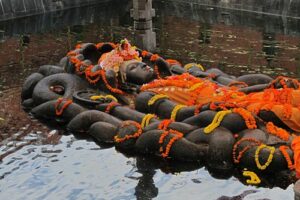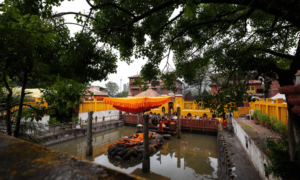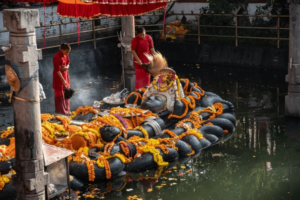Budhanilkantha Temple:
Budhanilkantha Temple, situated in Budhanilkantha, Nepal, is a Hindu open-air temple dedicated to Lord Mahavishnu. The Budhanilkantha Temple is located at the northern end of the Kathmandu Valley, beneath the Shivapuri Hill. The Kathmandu District’s Budhanilkantha municipality is where it is situated.
Read famous temples in Jammu & Kashmir
Budhanilkantha Temple, Kathmandu also known as the Narayanthan Temple in Hinduism, can be characterized by a massive reclining statue of Lord Mahavishnu. However, in the Buddhist world, the term “Buddhanilkantha” refers to one of the many incarnations of Avalokiteshvara. The name translates to “Blue-Throated Buddha.”The statue is considered to be around 1400 years old. Budhanilkantha, the temple’s main statue, is considered Nepal’s greatest stone carving. A 5m long, reclining statue of Vishnu can be found in Kathmandu, Nepal, at the floating Vishnu Temple, also known as Budhanilkantha.
Budhanilkantha Temple History:
According to Hindus, the name Budhanilkantha, which translates to “Old Blue Throat” from Sanskrit, was bestowed upon the god Shiva by the gods after he ingested poison to rescue the world. Among the ‘Trimurtis’, together with Brahma and Shiva, the statue represents the divinity Vishnu. Because it depicts a Buddha on its forehead, this statue holds great significance for Buddhist enthusiasts. In their view, it symbolizes Avalokiteshvara as a reclining naga. Many people travel to Buddhanilkantha because they think the water there can heal wounds and other ailments.
As per the tale, the spring that supplies water to the pond at the Budanilkantha temple is linked to Gosaikunda, meaning it has a direct connection to Shiva’s water source. Since the water pond on which the statue rests has its source in Gosaikunda, which is dedicated to Shiva, the reason for its name is Shiva even though the statue is dedicated to Vishnu. This is because Shiva drank the poison and stored it in his throat, causing him to develop blue throat.
Both Buddhists and Hindus consider this temple to be a holy place. It is regarded as evidence of the long-standing religious peace in the area.
Budhanilkantha Temple Mystery:
King Pratap Malla (1641-1674) is said to have seen a vision of the future. The king was said to have been cursed in the vision. They would pass away too soon if he came to visit. He came to believe that the kings of Nepal would perish if they went to the Budhanilkantha Temple as a result of this vision. Because they were afraid of the prophecy, members of the royal line, including the Nepalese kings following King Pratap Malla, never went to the temple.
For many years, the idea that the statue floats in the water was put out. In fact, the assertion was not supported or refuted by the limited availability of scientific rigor in 1957; nevertheless, a little piece of the rock did reveal that it was silica-based and had a surprisingly low density, much like lava rock.
Budhanilkantha Temple Timings:
The open & closing timings of Budhanilkantha Temple is 5.00 am – 7.00 pm
Budhanilkantha Temple Location:
Nepal Vipassana Meditation Center Rd 44600, Budhanilkantha 44600, Nepal
Festivals Celebrated at Budhanilkantha Temple:
Every year, on the eleventh day of the Hindu month of Kartika (October–November), thousands of pilgrims flock to the Budhanilkantha Temple for the Haribondhini Ekadashi Mela. The purpose of this unique rite is to awaken Lord Vishnu from his extended slumber. Every year, on auspicious festivals like Ekadashis, Harishayani, and Haribodhini of the Hindu lunar calendar, which celebrate Lord Vishnu’s four-month sleeping period, a large fair is also held at the temple area.
How to reach Budhanilkantha Temple:
From Kathmandu City Center:
Take a local microbus or public bus heading to Budhanilkantha from Ratna Park Bus Station (Old Bus Park).
The ride takes around 30–40 minutes and is budget-friendly.
From Other Areas:
Look for buses or micros marked “Budhanilkantha.” Locals or the driver can guide you to the correct vehicle.
If unsure, ask for directions to “Narayanthan,” another name for Budhanilkantha.
By Taxi
Taxis are a convenient and faster option.
From central Kathmandu, it’s about a 20–30 minute drive depending on traffic.
Negotiate the fare before starting the trip or ensure the driver uses the meter. Expect to pay around NPR 500–800 one way.
Walking or Cycling
For those who enjoy trekking or cycling, Budhanilkantha is around 8 km north of Kathmandu and offers scenic views along the way.
Budhanilkantha Temple to Pashupatinath Temple distance – 29 min (10.0 km) via Mahankal Rd
Budhanilkantha Temple Images:




